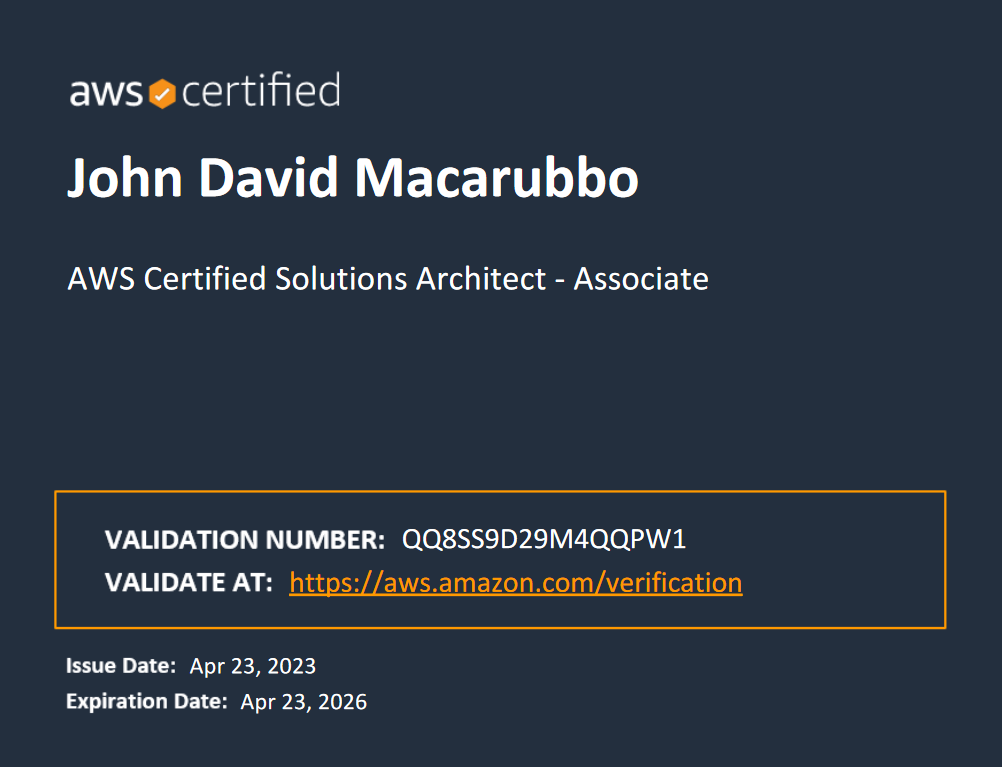How I Passed AWS Certified Solutions Architect - Associate (SAA-C03)

Three weeks after passing my AWS Certified Cloud Practitioner (CLF-C01), I took and passed my AWS Certified Solutions Architect - Associate (SAA-C03) exam, scoring 825 out of 1000. This is currently the hardest AWS certification that I experienced. In this article, I will share my experience and some tips and tricks that helped me guarantee my certification.
What are the Odds?
The Solutions Architect - Associate (SAA) exam needs serious preparation to guarantee a passing mark as it requires deeper knowledge of the services AWS offers and its use case, and how to build solutions around them based on different criteria inspired by AWS well-architected framework.
To give a better perspective on this, there might be questions that consider cost-effectiveness, security, resiliency, high availability, and other factors. Take a look at a sample scenario below:
A company wants to utilize AWS in building its client-facing website. They have clients all over the world that will visit the website. As a solutions architect, select the best answer to apply:
a. Deploy a t3.micro EC2 instance, use EBS volume to store files, install httpd, and serve the website
b. Create an S3 website, use CloudFront to serve the website
Both of the answers above will work, but b will provide better latency for clients in different parts of the world due to CloudFront's caching capability on multiple edge locations.
A lot of the questions in the exam would be like this: they'll provide certain situations and it requires a deeper understanding of how different AWS services work and how they interact with other services.
There are official practice questions as well as exam guide that AWS provided to give people a better picture of what to expect in the exam.
Preparation for the Exam
It took me 3 weeks to prepare for the exam, requiring me at least 3-4 hours of study time on weekdays and at least 8 hours on weekends. I utilized several strategies to grasp concepts and enforce learning retention:
- Watch video-based tutorials - The most time-consuming, yet the most effective way of learning for me. Though I initially used ACloudGuru's course, I find it lacking depth in some parts. I added Stephane Maarek's course to cover other aspects necessary to pass the exam.
- Hands-on Labs - There are a bunch of things that I struggled to understand, and getting my hands dirty with a lot of hands-on labs helped me understand complex concepts. From building a real-world use case for VPCs, real-time log analysis, and other complex use cases involving multiple AWS services, building them personally gave me a better perspective on how things work. This might be costly depending on the service that you're spinning up so be careful!
- Taking notes - Probably a simpler approach to learning retention, but it helped me a lot to enforce concepts into my mind. After a topic, I would stand up, walk around and dictate anything that I wrote. I would do it more than once if I feel necessary.
- Read AWS whitepapers - AWS provides a ton of whitepapers on different topics and they're worth checking out. To prepare for the exam, I specifically looked into well-architected framework and disaster recovery whitepapers as I learned that these topics might be part of the exam.
- Mock exams - Taking some mock exams helped me gauge my exam preparedness, but I only took them sparingly as I noticed that there's a subtle tendency for me to memorize the questions, which isn't helpful for scenario-based questions.
- Read people's experience - Looking at other people's perspectives on the exam can be beneficial as well. I read some articles from people who passed the exam, giving some details around exam coverage and how some things worked for them. It's up to you if you'll follow this advice.
Exam Day
I took the exam in the comfort of my home office. The proctor was nice and asked me to move my camera around to let her see my exam area. After that, I started taking the exam.
A lot of the questions are situational and it took me too long to read and understand the questions carefully. To save more time, I skipped these questions and came back to answer them later. With this strategy, I managed to save up around 90 minutes, enough for me to go through the exam questions twice.
Unlike my recent exam for AWS Certified Cloud Practitioner, the SAA exam doesn't let you know if you passed or fail after taking it, which made me nervous while waiting for the results. Luckily, I got an email for my digital badge 12 hours later, indicating that I passed the exam.
What's Next?
After passing the exam, I realized I have a lot of things to learn. But for now, I want to take a break. I spent a significant amount of time studying and it was exhausting.
I would get my 3rd AWS certification after a short break.
